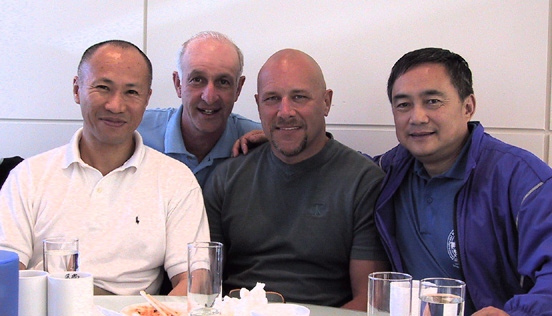

Founders left to right: Yuwa Hedrick-Wong, Michael Levenston, Al Arsenault, Shou-Yu Liang
International Wushu Sanshou Dao Association
The IWSD Association is a vehicle for members to learn new skills and to improve their martial arts ability. It functions as a bridge for martial artists all over the world to learn and share their knowledge, and to develop greater camaraderie between martial artists. The IWSD Association recognizes and encourages the uniqueness of various styles and traditions, but considers the cultivation of an individual's ability more important than the distinction that divides one style or tradition from another. Our goal includes transcending the boundaries between styles to allow for the integration of a highly practical and versatile system of martial skill.
See Shou-Yu Liang web site
The following biography is taken from the above web site.
Grandmaster Shou-Yu Liang is one of the recipients of the Coach of Excellence title, given only to the most outstanding Chinese martial arts instructors by the People’s Republic of China.
Grandmaster Liang’s martial arts ancestry originated five generations ago. He started his traditional Emei kungfu and Qigong training with his grandfather in 1948. Through the introduction of his grandfather, Grandmaster Liang then sought out other renowned masters and other styles from Shaolin and Wudang. In the early sixties, Grandmaster Liang began his study and research in the few major styles of Taiji such as Yang, Chen, Sun, and Wu style, Buddhist Esoteric Qigong, and Taoist Qigong. Grandmaster Liang had many times been a gold medalist in Wushu and Taiji competitions held in Sichuan province. Representing Sichuan province, he very often entered into highly competitive national and international competitions and won many gold medals. He was also a many-time gold medalist in Chinese wrestling, weight lifting and gymnastics competitions. In Sanshou and Taiji Push Hands competitions organized by non government sponsored communities, he was undefeated in all events he competed in. In the early sixties, he began his career as a university Wushu coach. His skill coupled with his kindness, generosity, sense of humour, and a ready smile had earned him the friendship and the heart of countless numbers of people.
Grandmaster Liang had been a many-time judge for the Chinese provincial and national professional Wushu competitions. Upon immigrating to Canada, Grandmaster Liang was elected head coach of the first Canadian National Wushu Team in 1985. Competing in the first world Wushu tournament in China that year, the Canadian team finished third. In 1986, in a tournament involving 28 nations, his Canadian team placed second, next only to the powerful China team. The Canadian success story shocked the Chinese nation, and news of their outstanding accomplishment spread throughout China.
Grandmaster Liang has many times been the head judge or the chairman of the judging team for national and international Wushu tournaments. He formerly held the positions of Chairman of Wushu, Taiji, Qigong instruction at the University of British Columbia Physical Education and Recreation Department. In 1987, Grandmaster Liang formally established the Shouyu Liang Wushu, Taiji and Qigong Institute in Vancouver,Canada. A year later he went on to found the International Wushu Sanshou Dao Association (IWSD) and was selected as the Chairperson. Today, still chaired by Grandmaster Liang, the IWSD has created branches in more than 20 countries around the world.
In 1994, Grandmaster Liang led the North American Marital Arts Exhibition Team for a friendship performance tour to ten major cities in China. His team received a warm welcome by the people and government of China. While in China, the team also competed in the international Wushu Competition held in Shanghai, for which 32 nations were represented. Grandmaster Liang’s team received 42 out of 56 gold medals awarded to the competitors. The Canadian Prime Minister at the time, Jean Chretien, also wrote a letter of encouragement to the team. Many Chinese television stations, radio stations, and newspapers spread the news of the Exhibition Team all over China.
Since 1985, most of the top ranked competitors in the Canadian and U.S. National and International Competitions are or have been students of Grandmaster Liang. Many of Grandmaster Liang’s students in China, the United States, and Canada have become distinguished instructors and coaches themselves.
Grandmaster Liang is well-known and respected internationally. He was selected by the China Wushu Magazine in the “Biography of Today’s Extraordinary Martial Artists”. He has been awarded the “World’s Top 100 Outstanding Martial Art Professional Award”, “World’s Greatest Contribution Award”, and “World’s Outstanding Accomplishment Award”. He has also been selected to be included in the “Current List of Famous Martial Artists” and in the Chinese “Who’s who in the world” as well as the “international Who’s Who of Professionals Historical Society” based in the United States-having demonstrated exemplary achievements and distinguished contributions to the business community.
Grandmaster Liang has written and produced numerous books and video tapes. Many of these books and video tapes had been translated into other languages such as French, Polish, Greek, Chinese, and Russian. He has been featured a great number of occasions on international television networks including Chinese Central Television(CCTV), Cable News Network(CNN), Discovery Channel and many other Canadian, Mexican, Greek, British and various European networks. He has also been featured on the covers of many prestigious Chinese, American, and Canadian newspapers and magazines. In 2002, Grandmaster Liang was bestowed the title of Life Time Honorary Chairman and ranked a 10th degree by the Confederation of Canadian Wushu Organizations – the highest level of Wushu achievement by that organization.
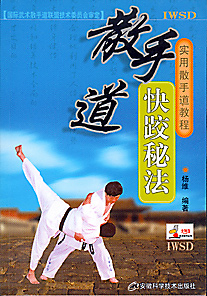
In 1994, Grandmaster Liang lead the North American Martial Arts Exhibition Team for a friendship performance tour to ten major cities in China. His team received a warm welcome by the people and government of China. While in China, the team also competed in the International Wushu Competition held in Shanghai. This competition was represented by 32 nations. Grandmaster Liang's team received 42 out of 56 gold medals awarded to the competitors. Canadian premier, Grandmaster Jean Chretien, also wrote a letter of encouragement to the team. Many Chinese television stations, radio stations, and newspapers spread the news of the Exhibition Team all over China.
Beginning in 1985, most of the Canadian National Wushu team members were Grandmaster Liang's students. Grandmaster Liang lead the Canadian National Wushu team to compete in the 1985 World Wushu Invitational Competition held in China. The Canadian team took the Team Third Place. In the following year, Grandmaster Liang again lead the Canadian Wushu Team to he World Wushu Invitational Competition held in China. This time, the team captured the Team Second Place which was second only to China. The Canadian success story shocked the Chinese nation, and news of their outstanding accomplishment spread throughout China.
Since 1985, most of the top ranked competitors in the U.S. National and International Competitions are or have been students of Grandmaster Liang. His students often received the top 3 places Wushu, Taijiquan, Xingyiquan, and Baguazhang competitions. Many of Grandmaster Liang's students in China, the United States, and Canada have become distinguished instructors and coaches themselves.
Grandmaster Liang is well-known and respected internationally. He has been featured on numerous occasions on international television stations, including Chinese, American, Canadian, British, and Mexican. Grandmaster Liang has also been featured on the covers of many prestigious Chinese, American, and Canadian magazines. He has written five books on Chinese healing and martial arts.
Director and Chief Strategist, Asian Foresight
Economic Advisor (Asia Pacific), MasterCard International
Economic Columnist, Forbes Asia
Dr. Yuwa Hedrick-Wong is a business strategist and economist with a wide range of professional experience gained in over thirty countries. He is a Canadian who grew up in Vancouver, British Columbia, and spent the last 20 years working in Europe, Sub-Sahara Africa, and Asia/ Pacific. He is the founding partner of the business strategy consulting firm Asian Foresight. He has served as strategy advisor to over thirty Forbes 500 companies in the Asia/Pacific region.
Yuwa also serves as MasterCard International's economic advisor in Asia/Pacific. In that capacity, he has been responsible for monitoring and forecasting economic growth and emerging business development trends in the region. In addition, he has devised market entry strategies, dissected and addressed public policy challenges, analyzed business impacts of demographic and lifestyle changes, and assessed market-specific business development potential and constraints.
In order to tap deeper local knowledge and market-specific insights, Yuwa chairs a knowledge panel of leading economists, policy analysts and business strategists in Asia/Pacific, with members including experts from China, Japan, South Korea, Hong Kong and Southeast Asia, for regular discussions and exchange of perspectives and knowledge sharing.
As a student of philosophy, political science, economics and history, Yuwa studied at Trent University, University of British Columbia, and Simon Fraser University in Canada. He received further post-graduate training in health economics, energy and resource economics, and scenario forecast and planning.
Yuwa is a frequent commentator on TV and in the media on current economic, policy and business issues in Asia Pacific, and a published author in consumer market dynamics in Asia, economic development, trade and international relations. He was guest lecturer at the Graduate School of Business, University of Chicago, Singapore (2000 – 2001); and visiting professor at the School of Management of Fudan University in Shanghai, China (2005).
Dr. Yuwa Hedrick-Wong, economic advisor, MasterCard Asia/Pacific, the "Communicator of the Year" Award
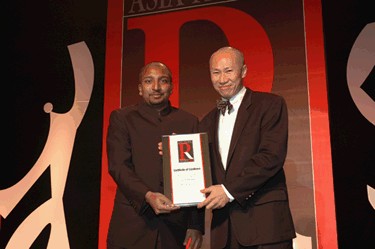
MasterCard captured two Certificate of Excellence Awards at the prestigious Asia Pacific PR Awards 2004 which recognizes outstanding public relations work across the region. The accolades were awarded in the "Communicator of the Year" and "Product & Promotion-Marketing Communications: Business" categories.
The Asia Pacific PR Awards are highly sought honors in the public relations industry, given annually to the best corporate and nonprofit teams, and the most outstanding communications professionals across Asia/Pacific. The awards not only celebrate organizations' successes, but also serve to motivate PR professionals to elevate their works to higher levels. This year, the PR Awards committee announced that it received well over 200 submissions representing the very best of the industry.
Communicator of the Year Award
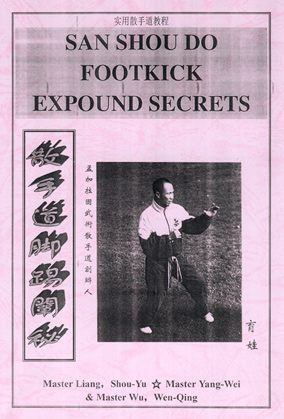
Impressed with his passion for his work and outstanding ability to connect with audiences, the judges awarded Dr. Yuwa Hedrick-Wong, economic advisor, MasterCard Asia/Pacific, the "Communicator of the Year" Award. Candidates were adjudicated not only on their achievement this year, but also their career accomplishments to date.
Photo: Dr. Yuwa Hedrick-Wong (right), economic advisor, MasterCard Asia/Pacific, receives his Communicator of the Year Award from Arun Sudhaman, Chairman, PR Awards.
In 2004, Yuwa has been interviewed and quoted in no less than 220 articles and more than 30 broadcast interviews in top-tier media outlets across Asia/Pacific. He has contributed substantive byline articles which have appeared in publications such as The Asian Wall Street Journaland The Economist. Journalists from across the world call him for comment on a range of topics-from rising oil prices and consumer sentiment to SARS. He is highly regarded by government, analysts, economists, business chiefs and industry leaders across Asia/Pacific.
Dr. Hedrick-Wong says, "The payment industry in Asia/Pacific continues to evolve at an extraordinary pace. For our customers, this means that the challenge of keeping up with the pulse of economic, social and business change is relentless. MasterCard has devoted extensive resources to developing a deep understanding of the region's consumers and payments patterns-and its business and economic context-through surveys and independent research studies. This is one of the many ways we support our customers."
Georgette Tan, Communications, MasterCard Asia/Pacific, commends Dr. Hedrick-Wong on his achievements: "This is a well-deserved award. Yuwa has given us his unfailing support and commitment over the years. He is a great asset to MasterCard and an important team player in the Communications group. This accolade recognizes his outstanding efforts to convey and demonstrate MasterCard's knowledge leadership position to our target audiences."
(i) "Mind the gap: Singapore investment in China", 2005, co-authored with Sharon Siddique and Sree Kumar. Singapore: Institute of Southeast Asian Studies.
(ii) "Holding up half of the sky: women in Asia's consumer markets", 2006, New York: John Wiley & Son.
(iii) "Silver aristocracy: the elderly consumer markets in Asia", 2006, New York: John Wiley & Son.
(iv) "Youth and the new consumer markets in Asia," 2006, New York: John Wiley & Son.
(v) "The platinum market: elite consumers of Asia", 2006, New York: John Wiley & Son.
Genetic Seeds of Warfare: Evolution, Nationalism, and Patriotism by Yuwa Hedrick-Wong and Paul R. Shaw, Boston, MA: Unwin Hyman
April 2006
Yuwa started training in Okinawa karate at the age of 11 in Hawaii under Sensei G. Sasaki. At age 17 he received his first degree black belt, and he eventually received his fifth degree black belt shortly before he turned 30. He also took classes in Yang style taichi under Sifu Andrew Lum intermittently for two years between the age of 14 and 16.
When he first visited Thailand on a research project in the early 1980s, which took him to the northeast of the country in Buriram Province, he had the opportunity to train with a local Muay Thai boxing school. He continued for a few years in the study of Muay Thai in subsequent visits to Thailand, both in the northeast and in Bangkok itself.
In the early 1980s he met Grand Master Shouyu Liang in Vancouver, B.C. Canada and started studying Chinese wushu and the internal styles with him. The training continued in the following decade. Through Master Liang, Yuwa was also introduced to Master Dr. Yang Zing Ming and learned from him white crane style kung fu and chin-na.
In the early 1980s, he met Sensei Koyabu, a teacher of Goju Ryu karate and trained with him for several years, including the study of bo (staff) techniques. In 1989 Yuwa moved to Ottawa, Ontario for one year where he studied Aiki Ryu jujitsu at Carleton University.
In the early 1990s he visited Heilongjiang Province, China, where he studied wushu, Chen style taichi and Chinese wrestling.
Yuwa started a karate class at Trent University where he was an undergraduate student and taught as the chief instructor from 1971 to 1974.
In 1975, spending a year in Banff, Alberta, he started a karate club there for the local community, which was taken over by his students after he left Banff for Vancouver in 1976.
In 1977 he started the West End Community Karate Club and taught there continuously for five years until 1982. After that he continued to teach a senior student seminar on a weekly basis for several more years.
In the early 1980s, he also started a karate club in resort community of Whistler, teaching jointly with R. Paul Shaw, a senior student of Sensei Koyabu.
While visiting Heilongjiang Province in China in the early 1990s, he was invited to teach karate and free style fighting to the provincial wushu team.
Over a period of three years when Yuwa took up project assignment in Bangladesh, he was invited to teach at the Black belt Academy in Dhaka, which is a Wado Ryu karate school. He introduced Okinawa karate there, in addition to teaching traditional weapons to the senior students.
Yuwa is a co-founder of Wushu Sansho Do, along side Master Shouyu Liang, Michael Levenston, and Al Arsenault.
It was 1971 when Mr. Arsenault began his martial arts training in North Bay, Ontario under the watchful eye of Sensei Duane Sawyer in Kenshokan Dharma, Goshin Jutsu. At this time, he had yet to hear of Bruce Lee who became a screen idol in the early 70's and started the 'Kung Fu craze' here in North America. He knew about the existence of judo, as it was an Olympic sport. Karate was just a word that he associated to a newly introduced fighting style and kung fu was relatively unheard of.
Mr. Arsenault threw himself intensely into karate during his university years (1972-78) at McMaster University in Hamilton, Ontario. He attained the rank of first kyu brown belt in Eastern's rough and tumble Goju Ryu Karate. After dabbling in Chito Ryu karate and obtaining his teaching degree at Queen's University in Kingston, he moved to Vancouver, British Columbia.
He joined the Vancouver Police Department in 1979, a career he retired from in 2006 as ‘Police Officer of the Year’. In Vancouver, he met Master Wong, Yuwa his karate instructor, or colleague as Yuwa now wishes to be called, and the true essence of karate unfolded under his expert and humble tutelage. Al was awarded his 3rd degree black belt from Dr. Wong in 1986. Al had never known such a technically brilliant yet utterly humble martial artist before. Master Wong encouraged his students in Nisei Karate-do to study all facets and styles of the martial arts and to utilize only what was useful for our temperaments and body types. Indeed, it was because of this freedom that one of Yuwa's long time karate students, Michael Levenston, came to study T'ai Chi Chu'an (Taijiquan) with Master Liang, Shou-Yu. In 1989, Michael introduced Master Liang to Yuwa and Al as being a 'living treasury of martial arts skill and knowledge'. Master Liang proved to be indeed just that. Al stopped teaching karate, referring to train with Master Liang. Soon the concept of Wushu Sanshou Dao was born in a gym at the University of British Columbia, where the few of them trained together (see early training photo). Sanshou Dao is basically the hybridization of the extensive and collective knowledge of these two masters with Michael and Al assisting in the meshing process whenever they could. This process still continues to grow worldwide today as they seek new skills to absorb into the slowly evolving sanshou style.
As his experience in the martial arts and street policing grew, Mr. Arsenault became interested mainly in the practical applications of the martial arts. He fought continuously with the students in his club despite a chronic back problem. Now at 50 years of age he still enjoys vigorous workouts. He obtained his black belt in judo under Tim Laidler, Brian Shipper, and Toby Hinton who head the Vancouver Police Judo Club and he serves as an assistant instructor at this club. Al is actively involved in teaching his fellow officers about police restraint and control tactics (within the judo club), he was a founding member of a Crowd Control Unit and he has been used extensively by the courts as an expert in non-firearm weaponry over the last two decades.
Today, he is also beginning to explore the creative side of his personality through writing and visual arts such as 'Odd Squad' filming of documentaries and educational videos like 'Through a Blue Lens' [1999], 'Flipping the World' [2000] and 'Beyond the Blue Lens' [2004] (see www.oddsquad.com).
Cst. Arsenault has had to arrest many violent offenders throughout the course of his career as a police officer. He has learned to read pre-assault cues and with the utmost speed, take the fight to his would-be assailant and put him quickly down to the ground without causing unnecessary harm. He likes to say that 'there is a time for talk and a time for action'. Not knowing the difference could mean a trip to the hospital to treat his injuries or to police Internal Affairs to explain his actions. He has always fought smarter, not harder and he only fights when he has to. Cst. Arsenault has chosen to stay exclusively on the street as opposed to taking the softer inside 'desk jockey' positions. A 'carpet cop' he is not. He takes pride in being a 'career constable' and being up to his elbows in the seedy and often violent part of society (in Vancouver's notorious skid road- the Downtown Eastside) where drug-induced human misery and surviving by instincts are the norm.
Having said this, Al advocates for a strict code of non-violence to his students other than for reasons of self-defense. If they must fight a righteous and unavoidable battle, he teaches them that there is no 'fair' fight, only personal survival. The amount of force they use must be proportionate to the amount of force used against them, in accordance with our laws. With such a training environment, few bullies or hot heads are attracted. These types soon leave or are shown the way out. And so our students must learn the distinction between self-serving violence and the judicious application of force for the common good of all. For over a decade, Al has served as the President of the International Wushu Sanshou Dao Association that Master Liang, Shou-Yu, Dr. Wong, Yuwa and Dr. Yang, Jwing-Ming formed in 1988. In 1997, Master Liang awarded Al a 5th degree black belt in Sanshou Dao, a degree that is humbly acknowledged as being largely an honorary one. The SYL Institute in Vancouver is immensely popular and our students successfully compete internationally. Indeed, Master Liang has a large contingent of both local (see group photo) and international students. Sanshou Dao has spread to China and elsewhere, taking on the flavors of other styles of martial arts to give it additional strength and depth.
It is Al's sincere hope that the cross training in martial art styles flourishes in the new millennium and that this book in some small way serves to assist in this endeavor.
VPD Board of Trade's inaugural award goes to Const. Al Arsenault
BY LORI CULBERT VANCOUVER SUN Sat Sept 17
VANCOUVER It was 1989. Vancouver Police Const. Al Arsenault was sitting on a bus in China, where he was on a martial arts trip. The young Chinese man sitting across the aisle began speaking English, and Arsenault noticed he had a portable radio.
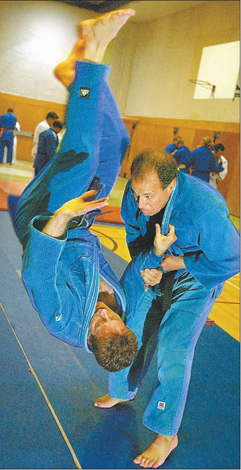
"I said to my friend, 'That looks like one our police portable radios,' " recalled Arsenault, who thought he recognized the teenager's face. The 17-year-old explained he was from Vancouver and was on the city police department.
Arsenault knew it was a lie. And he suddenly remembered where he'd seen that face before: on a poster warning about a "disturbed police impersonator."
The engraving on the radio confirmed it belonged to the VPD and the young man was carrying phoney police ID and notes about police phrases. The teen was a Canadian citizen, and Arsenault didn't have the heart to turn him over to the Chinese authorities. But once the young man returned to Vancouver, he was charged with possession of stolen property. He said he took the radio three months earlier from a dog squad car at a break-and-enter. Arsenault knew the details of the call - he'd been at the scene when the radio was stolen.
"He happened to be in China the same time as I was, he happened to sit beside me on the bus, we happened to talk about policing, and I happened to be on the call when the radio was taken," Arsenault laughed, still amazed at the number of coincidences in the story.
Over his 26 years as a police officer, Arsenault has many memories - funny, scary, sad, frustrating, encouraging. Friday, the Vancouver Board of Trade paid tribute to his career by giving him the first ever Spirit of Vancouver Police Officer of the Year Award. Arsenault, who was named top recruit of his class as a rookie in 1980, receives this latest accolade near the end of his career - less than a year before he is to retire.
"But the 25 years in between were a little dodgy," he joked. The Board of Trade acknowledged Arsenault's work with Odd Squad Productions, a non-profit society he helped form in 1998, which produced the awardwinning film Through A Blue Lens. The most encouraging and disappointing memories of his career come from two of the addicts featured in the film: one is now clean but another, April Reoch, has been murdered. "She was our poster girl," he said. "I still get choked up talking about her."
Arsenault, who has chosen to continue walking the beat in the Downtown Eastside, makes anti-drug presentations to students and speaks internationally about policing and drug issues. He is harshly critical of harm-reduction initiatives, and is not scared to ruffle feathers by arguing that the way to cure drug addiction is "abstinence and treatment."
One of his scariest moments on the job came as he worked as a decoy for Operation Oldtimer, in which police officers posed as passed-out seniors in the Downtown Eastside to catch the thieves who robbed them. "Even though my cover was seconds away, someone can knife you in the neck so fast," he said. The operation was successful, resulting in six arrests. "We were so incensed in seeing these old people getting pummelled in the alleyways. We thought we had to do something about it."
And one of his most unbelievable memories was giving CPR to police dog Bear, who was electrocuted on a call. Arsenault thought the canine was dead, but continued to do chest compressions while the dog master gave mouth-tomouth resuscitation. With sirens wailing on the way to the vet, the dog started to move. "I can feel the dog had a pulse. A few seconds later the dog is breathing," he recalled.
The father of a 20-year-old daughter, an author and a martial arts expert, Arsenault plans to write more books, produce more films, and do a master's degree in criminology when he retires. But he won't be leaving the police department entirely.
His common-law spouse, a former chartered accountant, has entered the newest recruit class, and will become a VPD member next spring - about the same time Arsenault retires. "She's going in when I'm going out," he laughed.
Chin Na In Ground Fighting-Principles, Theory, and Submission Holds for All Martial Styles, By Al Arsenault, 2003
Martial Arts Biography
Born 1951, Toronto, Canada
My first experience of martial arts was learning Western boxing as part of physical education training at elementary school when I was 11 or 12 years old. Our school, based on the British educational system, had a traditional boxing ring and timed matches. We wore boxing gloves and shorts.
At Trent University, Yuwa Hedrick-Wong PhD. ran the campus Karate Club, which I joined in 1971. We trained hard for three years, ran along snow covered country roads in winter, and sparred ferociously with fellow students in the large dining hall we used as a dojo after dinner hour.
Following Sensei Wong to Vancouver in 1976, I continued to train at the West End Community Centre where a growing number of senior black belts raised the level of knowledge and improved our training. At that same time we began learning traditional Japanese weapons (bunkai) with Sensei Tomoaki Koyabu of the Goju Ryu Style.
Sensei Wong began a separate Taiji class in 1977, which he asked me to teach in 1978. During that time I met my wife Joan MacNab, also a black belt in Karate and a long time martial artist.
To gain more knowledge of internal Chinese martial arts, I joined Master Raymond Chung's Yang Style school and studied the traditional long form, push hands and two man set. When Master Chung's wife, son and daughter came from China in 1981, I began learning Chen Style with Mrs. Chung and then Fu Style Taiji with Sifu Ken Chung who was a long time student of Fu Wing Fai (son of the founder). Ken also introduced me to Xing-Yi and Bagua.
In 1982, Master Shou-Yu Liang came to Vancouver and was made Chairman of Wushu, Taiji, Qigong instruction at the University of British Columbia Physical Education and Recreation Department. I became one of his first students in Canada and was amazed at what a wealth of Wushu knowledge he possessed. We still consider it "encyclopedic". Master Liang shared everything he knew with us in an honest and friendly manner. Through the years I have studied many internal styles with him including Chen, Sun, Wu styles of Taiji, Xing-Yi and Bagua, Liu He Ba Fa (Water Style), many external forms from his home Province of Sichuan (Emei Styles) and all sorts of weapons. Also I have studied Shuai Jiao (Chinese wrestling), Qinna and a secret family Iron Shirt Style taught to Mr. Liang by his grandfather. Our Sansho fighting practice includes jujitsu and ground techniques.
After 25 years, I continue to learn from Master Liang and sincerely hope I can continue this training for another 25 years.
My teaching experience includes classes in self-defense at Vancouver high schools, in Taiji in community centres, and in fighting (sanshou) at the Shou-Yu Liang Institute.
Mayor of Vancouver Proclaims November "City Farmer Month"
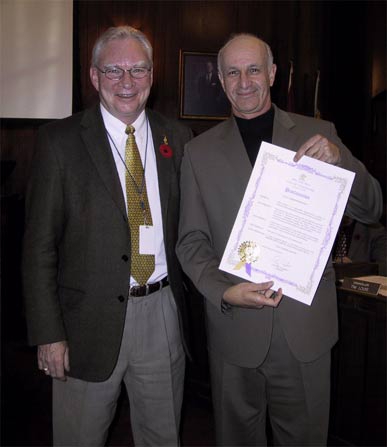
WHEREAS City Farmer is a nonprofit organization working to promote environmentally responsible urban agriculture;
AND WHEREAS City Farmer has done excellent and cost effective work for the City of Vancouver and the communities of Greater Vancouver, including running the City's compost and waterwise demonstration garden, the City's natural yard care promotion and the regional compost hotline;
AND WHEREAS City Farmer is recognized as one of the leaders in providing service and information out to the world about urban agriculture, waste reduction and sustainability;
AND WHEREAS This year is City Farmer's 25th anniversary:
NOW, THEREFORE, I, Larry Campbell, Mayor of the City of Vancouver, DO HEREBY PROCLAIM the month of November 2003 as
"CITY FARMER MONTH" in the City of Vancouver.
Larry W. Campbell, MAYOR
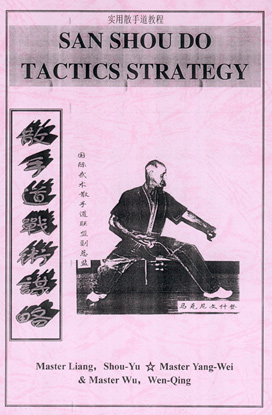
By Michael Levenston
October 2012
The Great Hall in Champlain College has a place in the story of a modern martial art that today boasts thousands of members around the world.
Back in 1970, young men and women dressed in white karate gis would enter the Great Hall after supper and lift the heavy wooden tables to one end of the hall to make a makeshift gymnasium. They then did their best to sweep up left over food and other refuse that students had spilled from their plates onto the cold, hard tiles. The class was always conducted barefoot, so the fewer squishes underfoot, the more pleasant the experience.
Our instructor was a muscular, long-haired enthusiast of seventeen named Yuwa Hedrick-Wong who had arrived via San Francisco from Hawaii with his black belt in Goju-ryu karate. He had attended Punahou School in Honolulu, the same school that Barack Obama attended a few years later.
Yuwa became friends with his fellow students, laughed to encourage them as he taught, and lead a grueling workout long before the days of 'boot camps'. He was also a brilliant scholar and helped students after class with their studies.
In the dark winter evenings you could see Trent students in their whites running along the unlit road next to the Otonabee River, snow piled up around them, their breath crystallizing as they struggled back to the College. After the energetic class, some participants would socialize naked in the co-ed saunas in Lady Eaton and Champlain until late into the night. A great bond of friendship developed amongst them.
Sparring was mandatory and students got their first experience of blows to the gut or head. Yuwa was a huge supporter of women in karate, encouraging them to participate and cautioning men to be respectful and helpful in training. This was the era when Bruce Lee was making his classic films, Chuck Norris was a fighting star, and stories about Japanese master Mas Oyama fighting bulls bare-handed circulated. We were caught up in the mythology of supermen with secret powers.
By 1974 we'd finished our studies and had gone our separate ways. Trent's first martial arts school was no more. Yuwa moved to Vancouver in 1976 and began training in his basement. I moved out West as well and resumed my training there. Soon he opened a formal school in the West End Community Centre, a hub of activity in the heart of one of Canada's densest populations. New students flocked to the energetic karate classes to learn Yuwa's 'Nisei Karate-do'. On occasion, fellow Trent karateka Cindy Connor and James MacKinnon would fly out from Ontario to train with their classmates in Vancouver. Trevor Davies, another old Trent student, became the senior black belt in the West Coast class, which trained many exceptional black belts, men and women. There I met Joan who became my wife.
In the early 1980's, Yuwa, myself and another senior student, a police officer named Al Arsenault, began to study with Master Shou-yu Liang, a world famous Chinese martial arts instructor who had just moved to Vancouver to take up the unique position of 'Chairman of Wushu, Taiji, Qigong Instruction' at the University of BC Physical Education and Recreation Department. As we began to train with him, a close friendship grew as did our respect for his skills and encyclopedic knowledge of the whole breadth of Chinese 'wushu' (popularly called 'kungfu' in the West). When we sparred, we used both our karate skills and his Chinese traditional techniques.
Out of this practice emerged the concept of a new martial art, which we formed in 1987 and named 'Sanshou Dao'. It would "transcend the boundaries between styles to allow for the integration of a highly practical and versatile system of martial skills," wrote Yuwa in the Member Handbook. "It functions as a bridge for martial artists all over the world to learn and share their knowledge, and to develop greater camaraderie between martial artists."
Today, International Wushu Sanshou Dao (IWSD), has become a global association of martial artists encompassing thousands of students in over 150 different branch schools, in China, Russia, Singapore, Poland, Italy, Germany, France, England, Canada and the USA. Over 100 teachers in the association hold 6th degree black belts and above. Many illustrious Chinese masters are on the advisory board having joined out of respect for Master Liang's accomplishments. The IWSD has published three large-format pictorial books titled Extraordinary Martial Artists of the World. It also holds numerous competitions and an International Wushu Cultural Tour and Festival each year in cities across China.
Yuwa and Michael, two of the 'Founders' of this international martial art, are proud of their Trent heritage and remember with great happiness their days practicing in the Great Hall at Champlain College. They continue to practice martial arts into their sixth decade.
Yuwa Hedrick-Wong is a global economist and business strategist. He is the HSBC Distinguished Visiting Professor of International Business at the University of British Columbia in Canada, as well as being the global economic advisor to MasterCard, ICICI and Southern Capital Group. Michael Levenston is the Executive Director of City Farmer Society, an urban agriculture group and education centre he helped start in 1978.
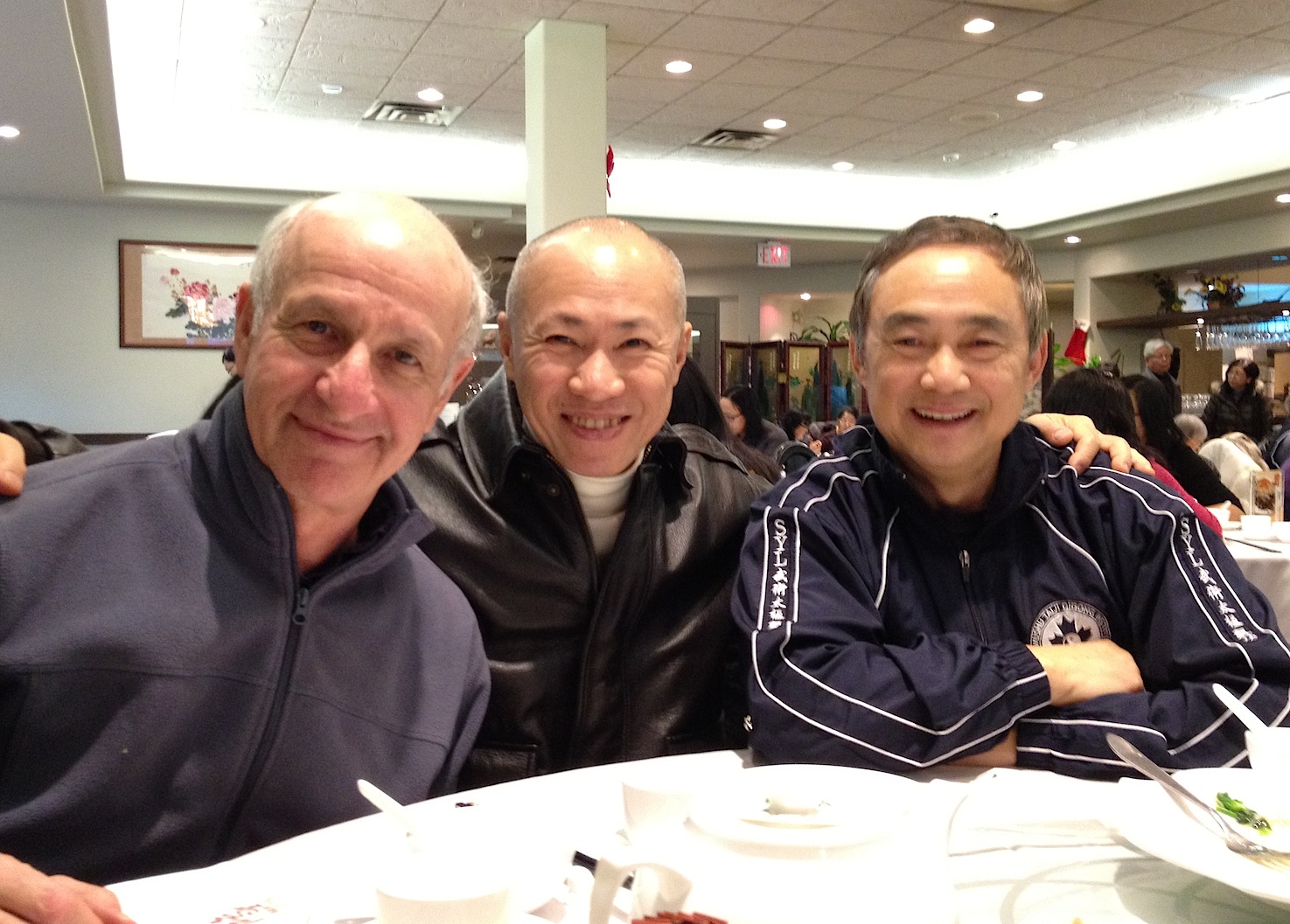
Three sitting in 2012. l-r: Michael Levenston, Yuwa Hedrick-Wong, Shou-yu Liang.